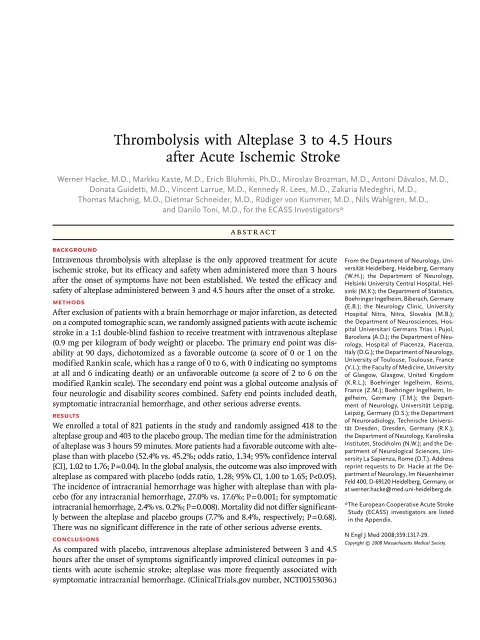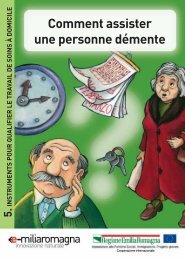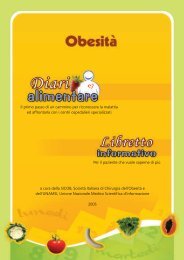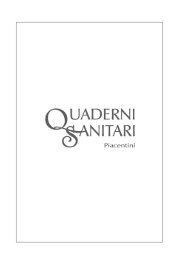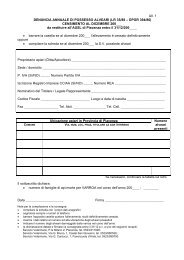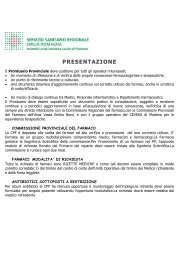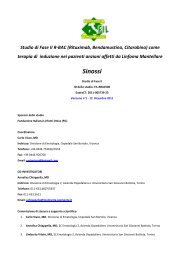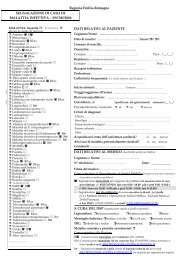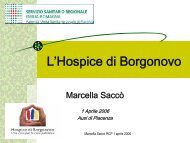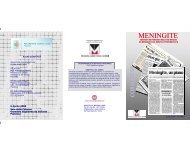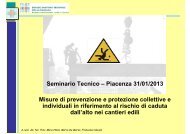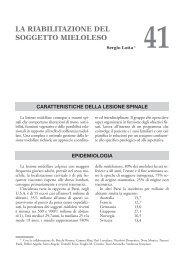Thrombolysis with Alteplase 3 to 4.5 Hours after Acute Ischemic Stroke
Thrombolysis with Alteplase 3 to 4.5 Hours after Acute Ischemic Stroke
Thrombolysis with Alteplase 3 to 4.5 Hours after Acute Ischemic Stroke
Create successful ePaper yourself
Turn your PDF publications into a flip-book with our unique Google optimized e-Paper software.
<strong>Thrombolysis</strong> <strong>with</strong> <strong>Alteplase</strong> 3 <strong>to</strong> <strong>4.5</strong> <strong>Hours</strong><br />
<strong>after</strong> <strong>Acute</strong> <strong>Ischemic</strong> <strong>Stroke</strong><br />
Werner Hacke, M.D., Markku Kaste, M.D., Erich Bluhmki, Ph.D., Miroslav Brozman, M.D., An<strong>to</strong>ni Dávalos, M.D.,<br />
Donata Guidetti, M.D., Vincent Larrue, M.D., Kennedy R. Lees, M.D., Zakaria Medeghri, M.D.,<br />
Thomas Machnig, M.D., Dietmar Schneider, M.D., Rüdiger von Kummer, M.D., Nils Wahlgren, M.D.,<br />
and Danilo Toni, M.D., for the ECASS Investiga<strong>to</strong>rs*<br />
ABSTRACT<br />
Background<br />
Intravenous thrombolysis <strong>with</strong> alteplase is the only approved treatment for acute<br />
ischemic stroke, but its efficacy and safety when administered more than 3 hours<br />
<strong>after</strong> the onset of symp<strong>to</strong>ms have not been established. We tested the efficacy and<br />
safety of alteplase administered between 3 and <strong>4.5</strong> hours <strong>after</strong> the onset of a stroke.<br />
Methods<br />
After exclusion of patients <strong>with</strong> a brain hemorrhage or major infarction, as detected<br />
on a computed <strong>to</strong>mographic scan, we randomly assigned patients <strong>with</strong> acute ischemic<br />
stroke in a 1:1 double-blind fashion <strong>to</strong> receive treatment <strong>with</strong> intravenous alteplase<br />
(0.9 mg per kilogram of body weight) or placebo. The primary end point was disability<br />
at 90 days, dicho<strong>to</strong>mized as a favorable outcome (a score of 0 or 1 on the<br />
modified Rankin scale, which has a range of 0 <strong>to</strong> 6, <strong>with</strong> 0 indicating no symp<strong>to</strong>ms<br />
at all and 6 indicating death) or an unfavorable outcome (a score of 2 <strong>to</strong> 6 on the<br />
modified Rankin scale). The secondary end point was a global outcome analysis of<br />
four neurologic and disability scores combined. Safety end points included death,<br />
symp<strong>to</strong>matic intracranial hemorrhage, and other serious adverse events.<br />
Results<br />
We enrolled a <strong>to</strong>tal of 821 patients in the study and randomly assigned 418 <strong>to</strong> the<br />
alteplase group and 403 <strong>to</strong> the placebo group. The median time for the administration<br />
of alteplase was 3 hours 59 minutes. More patients had a favorable outcome <strong>with</strong> alteplase<br />
than <strong>with</strong> placebo (52.4% vs. 45.2%; odds ratio, 1.34; 95% confidence interval<br />
[CI], 1.02 <strong>to</strong> 1.76; P = 0.04). In the global analysis, the outcome was also improved <strong>with</strong><br />
alteplase as compared <strong>with</strong> placebo (odds ratio, 1.28; 95% CI, 1.00 <strong>to</strong> 1.65; P
Intravenous thrombolytic treatment<br />
<strong>with</strong> alteplase, initiated <strong>with</strong>in 3 hours <strong>after</strong><br />
the onset of symp<strong>to</strong>ms, is the only medical<br />
therapy currently available for acute ischemic<br />
stroke. In 1995, the National Institute of Neurological<br />
Disorders and <strong>Stroke</strong> (NINDS) study group<br />
reported that patients <strong>with</strong> acute ischemic stroke<br />
who received alteplase (0.9 mg per kilogram of<br />
body weight) <strong>with</strong>in 3 hours <strong>after</strong> the onset of<br />
symp<strong>to</strong>ms were at least 30% more likely <strong>to</strong> have<br />
minimal or no disability at 3 months than those<br />
who received placebo. 1 Two European trials, the<br />
European Cooperative <strong>Acute</strong> <strong>Stroke</strong> Study (ECASS)<br />
and ECASS II, investigated a time window of up<br />
<strong>to</strong> 6 hours but failed <strong>to</strong> show the efficacy of thrombolytic<br />
treatment, as defined by each trial. 2,3<br />
A subsequent analysis of the NINDS study 4<br />
and the combined analysis 5 of data from six randomized<br />
trials, 1-3,6,7 which investigated thrombolysis<br />
treatment for ischemic stroke in a <strong>to</strong>tal<br />
of 2775 patients, showed a clear association between<br />
treatment efficacy and the interval between<br />
the onset of symp<strong>to</strong>ms and administration of the<br />
thrombolytic agent. In the pooled analysis, a favorable<br />
outcome was observed even if treatment<br />
was given between 3 and <strong>4.5</strong> hours, <strong>with</strong> an odds<br />
ratio of 1.4 for a favorable outcome <strong>with</strong> alteplase<br />
treatment as compared <strong>with</strong> placebo. This<br />
analysis also suggested that the longer time<br />
window, as compared <strong>with</strong> the shorter window,<br />
was not associated <strong>with</strong> higher rates of symp<strong>to</strong>matic<br />
intracranial hemorrhage or death. 5 International<br />
guidelines recommend alteplase as a<br />
first-line treatment for eligible patients when<br />
administered <strong>with</strong>in 3 hours <strong>after</strong> the onset of<br />
stroke. 8-10 Despite this recommendation, alteplase<br />
is underused; it is estimated that fewer than 2%<br />
of patients receive this treatment in most countries,<br />
primarily because of delayed admission <strong>to</strong><br />
a stroke center. 11<br />
<strong>Thrombolysis</strong> <strong>with</strong> alteplase has been approved<br />
in most countries. In Europe, the European<br />
Medicines Agency (EMEA) granted approval of<br />
alteplase in 2002 but included two requests. One<br />
request was that an observational safety study be<br />
initiated; subsequently, the Safe Implementation<br />
of <strong>Thrombolysis</strong> in <strong>Stroke</strong>–Moni<strong>to</strong>ring Study<br />
(SITS–MOST) was undertaken. This study confirmed<br />
that alteplase is as safe and effective in<br />
routine clinical practice as it is in randomized<br />
trials. 12 The second request was that a random-<br />
ized trial be conducted in which the therapeutic<br />
time window was extended beyond 3 hours.<br />
We describe the results of ECASS III, a randomized,<br />
placebo-controlled, phase 3 trial designed<br />
<strong>to</strong> test the hypothesis that the efficacy of<br />
alteplase administered in patients <strong>with</strong> acute<br />
ischemic stroke can be safely extended <strong>to</strong> a time<br />
window of 3 <strong>to</strong> <strong>4.5</strong> hours <strong>after</strong> the onset of stroke<br />
symp<strong>to</strong>ms.<br />
Methods<br />
Patient Population and Study Design<br />
ECASS III was a double-blind, parallel-group trial<br />
that enrolled patients from multiple centers across<br />
Europe (see the Appendix). Patients were eligible<br />
for inclusion in the study if they were 18 <strong>to</strong> 80<br />
years of age, had received a clinical diagnosis of<br />
acute ischemic stroke, and were able <strong>to</strong> receive<br />
the study drug <strong>with</strong>in 3 <strong>to</strong> 4 hours <strong>after</strong> the onset<br />
of symp<strong>to</strong>ms. A cerebral computed <strong>to</strong>mographic<br />
(CT) scan was required before randomization <strong>to</strong><br />
exclude patients who had an intracranial hemorrhage<br />
or major ischemic infarction. In some cases,<br />
magnetic resonance imaging (MRI) was performed<br />
instead of CT (Fig. 1). The inclusion and<br />
exclusion criteria are summarized in Table 1. In<br />
May 2005, <strong>after</strong> 228 patients had been enrolled,<br />
the study pro<strong>to</strong>col was amended, and the time<br />
window of 3 <strong>to</strong> 4 hours was extended by 0.5 hour<br />
(3 <strong>to</strong> <strong>4.5</strong> hours). There were two reasons for the<br />
extension of the time window: the publication of<br />
the pooled analysis, which suggested that patients<br />
may benefit from thrombolytic treatment administered<br />
up <strong>to</strong> <strong>4.5</strong> hours <strong>after</strong> the onset of symp<strong>to</strong>ms,<br />
5 and a slow rate of patient recruitment.<br />
The trial pro<strong>to</strong>col and the amendments were accepted<br />
by the EMEA and were approved by the<br />
institutional review boards of the participating<br />
centers. All patients or legally authorized representatives<br />
gave written informed consent before<br />
enrollment.<br />
Randomization and Treatment<br />
Eligible patients were randomly assigned, in a 1:1<br />
ratio, <strong>to</strong> receive 0.9 mg of alteplase (Actilyse,<br />
Boehringer Ingelheim) per kilogram, administered<br />
intravenously (<strong>with</strong> an upper limit of 90 mg), or<br />
placebo. An interactive voice-randomization system<br />
was used, <strong>with</strong> randomization at centers<br />
performed in blocks of four <strong>to</strong> ensure a balanced
43 Were excluded from the perpro<strong>to</strong>col<br />
analyses<br />
12 Did not receive treatment<br />
4 Had uncontrolled hypertension<br />
10 Did not meet age criterion<br />
10 Did not meet CT criteria<br />
1 Received treatment outside<br />
3–<strong>4.5</strong>-hr window<br />
6 Had other reason<br />
418 Were assigned <strong>to</strong> receive<br />
alteplase and were included in the<br />
intention-<strong>to</strong>-treat population<br />
375 Received alteplase and were<br />
included in the per-pro<strong>to</strong>col<br />
population<br />
The intention<strong>to</strong>treat population was defined<br />
AUTHOR:<br />
as all<br />
Hacke<br />
patients who were enrolled RETAKE and 1st randomly assigned <strong>to</strong> a study<br />
ICM<br />
group. The perpro<strong>to</strong>col population was defined as all randomly assigned patients who<br />
REG F FIGURE: 1 of 2<br />
2nd received alteplase or placebo<br />
and who were not excluded because of major pro<strong>to</strong>col violations, which included, most 3rd notably, noncompliance<br />
CASE<br />
<strong>with</strong> the current European Summary of Product Characteristics for alteplase Revised (excluding time window of treatment).<br />
EMail<br />
Line 4-C<br />
Of the randomly assigned patients, 771 were SIZE<br />
ARTIST: evaluated ts by means of CT and 50 by means of MRI at baseline. Among<br />
H/T H/T<br />
Enon<br />
33p9<br />
the 418 patients assigned <strong>to</strong> treatment <strong>with</strong> alteplase, 13 were Combo lost <strong>to</strong> followup, and among the 403 patients assigned<br />
<strong>to</strong> receive placebo, 10 were lost <strong>to</strong> followup; the worst possible outcome for the primary end point was imputed for<br />
AUTHOR, PLEASE NOTE:<br />
these patients. Among those excluded Figure from has perpro<strong>to</strong>col been redrawn analyses, and type reasons has been for reset. exclusion listed as “other” included<br />
a his<strong>to</strong>ry of both stroke and diabetes, treatment <strong>with</strong> Please an check oral anticoagulant carefully. <strong>with</strong>in 24 hours, broken medication<br />
code, treatment <strong>with</strong> a prohibited medication, no ischemic stroke, and either no informed consent or <strong>with</strong>drawal<br />
of consent.<br />
JOB: 35913<br />
ISSUE: 09-25-08<br />
distribution of group assignments at any time.<br />
The size of the blocks was <strong>with</strong>held from the investiga<strong>to</strong>rs<br />
<strong>to</strong> make sure that they were unaware<br />
of the treatment assignments. <strong>Alteplase</strong> and<br />
matched placebo were reconstituted from a lyophilized<br />
powder in sterile water for injection. Of<br />
the <strong>to</strong>tal dose, 10% was administered as a bolus,<br />
and the remainder was given by continuous intravenous<br />
infusion over a period of 60 minutes.<br />
With the exception of the extended time window,<br />
alteplase was <strong>to</strong> be used in accordance <strong>with</strong> current<br />
European labeling.<br />
821 Patients were enrolled<br />
821 Underwent randomization<br />
403 Were assigned <strong>to</strong> receive<br />
placebo and were included in the<br />
intention-<strong>to</strong>-treat population<br />
355 Received placebo and were<br />
included in the per-pro<strong>to</strong>col<br />
population<br />
48 Were excluded from the perpro<strong>to</strong>col<br />
analyses<br />
13 Did not receive treatment<br />
13 Had uncontrolled hypertension<br />
6 Did not meet age criterion<br />
7 Did not meet CT criteria<br />
7 Received treatment outside<br />
3–<strong>4.5</strong>-hr window<br />
2 Had other reason<br />
Figure 1. Numbers of Patients Who Were Enrolled, Randomly Assigned <strong>to</strong> a Study Group, and Included in the Per-<br />
Pro<strong>to</strong>col Population.<br />
Study Management<br />
The steering committee designed and oversaw the<br />
trial. An independent data and safety moni<strong>to</strong>ring<br />
board regularly moni<strong>to</strong>red the safety of the trial.<br />
The data and safety moni<strong>to</strong>ring board did not<br />
have access <strong>to</strong> functional outcome data but received<br />
a group assignment of A or B for death<br />
and C or D for moni<strong>to</strong>ring of symp<strong>to</strong>matic intracranial<br />
hemorrhage <strong>to</strong> ensure unbiased review of<br />
each of the two main safety outcomes. The chair<br />
of the data and safety moni<strong>to</strong>ring board, who<br />
contributed <strong>to</strong> the design of the trial but had no
Table 1. Major Inclusion and Exclusion Criteria.<br />
Main inclusion criteria<br />
<strong>Acute</strong> ischemic stroke<br />
Age, 18 <strong>to</strong> 80 years<br />
Onset of stroke symp<strong>to</strong>ms 3 <strong>to</strong> <strong>4.5</strong> hours before initiation of studydrug administration<br />
<strong>Stroke</strong> symp<strong>to</strong>ms present for at least 30 minutes <strong>with</strong> no significant improvement before treatment<br />
Main exclusion criteria<br />
Intracranial hemorrhage<br />
Time of symp<strong>to</strong>m onset unknown<br />
Symp<strong>to</strong>ms rapidly improving or only minor before start of infusion<br />
Severe stroke as assessed clinically (e.g., NIHSS score >25) or by appropriate imaging techniques*<br />
Seizure at the onset of stroke<br />
<strong>Stroke</strong> or serious head trauma <strong>with</strong>in the previous 3 months<br />
Combination of previous stroke and diabetes mellitus<br />
Administration of heparin <strong>with</strong>in the 48 hours preceding the onset of stroke, <strong>with</strong> an activated partial thromboplastin<br />
time at presentation exceeding the upper limit of the normal range<br />
Platelet count of less than 100,000 per cubic millimeter<br />
Sys<strong>to</strong>lic pressure greater than 185 mm Hg or dias<strong>to</strong>lic pressure greater than 110 mm Hg, or aggressive treatment<br />
(intravenous medication) necessary <strong>to</strong> reduce blood pressure <strong>to</strong> these limits<br />
Blood glucose less than 50 mg per deciliter or greater than 400 mg per deciliter<br />
Symp<strong>to</strong>ms suggestive of subarachnoid hemorrhage, even if CT scan was normal<br />
Oral anticoagulant treatment<br />
Major surgery or severe trauma <strong>with</strong>in the previous 3 months<br />
Other major disorders associated <strong>with</strong> an increased risk of bleeding<br />
* A severe stroke as assessed by imaging was defined as a stroke involving more than one third of the middle cerebralartery<br />
terri<strong>to</strong>ry. NIHSS denotes National Institutes of Health <strong>Stroke</strong> Scale in which <strong>to</strong>tal scores range from 0 <strong>to</strong> 42, <strong>with</strong><br />
higher values reflecting more severe cerebral infarcts.<br />
role in the conduct of the study, was invited <strong>to</strong> be<br />
part of the writing committee <strong>after</strong> completion<br />
of the trial. Moni<strong>to</strong>ring and data management<br />
were undertaken by the sponsor of the trial. Statistical<br />
analyses were performed simultaneously<br />
by an independent external statistician and the<br />
statistician of the sponsor. The steering committee<br />
had complete access <strong>to</strong> the trial data <strong>after</strong> the<br />
database had been locked and assumed complete<br />
responsibility for the final statistical analysis and<br />
interpretation of the results. All study committees<br />
are listed in the Appendix. All the authors vouch<br />
for the accuracy and completeness of the data<br />
and analyses.<br />
Concomitant Therapies<br />
Treatment <strong>with</strong> intravenous heparin, oral anticoagulants,<br />
aspirin, or volume expanders such as<br />
hetastarch or dextrans during the first 24 hours<br />
<strong>after</strong> administration of the study drug had been<br />
completed was prohibited. However, the use of<br />
subcutaneous heparin (≤10,000 IU), or of equivalent<br />
doses of low-molecular-weight heparin, was<br />
permitted for prophylaxis against deep-vein<br />
thrombosis.<br />
Clinical Assessment<br />
Patients were assessed by an examiner who was<br />
unaware of the treatment assignment. Assessments<br />
were made at the time of enrollment, at 1,<br />
2, and 24 hours <strong>after</strong> administration of the study<br />
drug was begun, and on days 7, 30, and 90 <strong>after</strong><br />
administration of the drug. In addition, the patients’<br />
clinical condition (e.g., blood pressure, oxygenation,<br />
and heart rate) was closely moni<strong>to</strong>red<br />
for the first 24 hours. Initial assessments included<br />
a physical examination, CT or MRI, and the quantification<br />
of any neurologic deficit <strong>with</strong> the use<br />
of the National Institutes of Health <strong>Stroke</strong> Scale<br />
(NIHSS), a 15-item scale that measures the level<br />
of neurologic impairment. Total scores on the<br />
NIHSS range from 0 <strong>to</strong> 42, <strong>with</strong> higher values
eflecting more severe cerebral infarcts (
gression) of the primary end point was undertaken<br />
in the intention-<strong>to</strong>-treat population. This<br />
analysis was performed by including all baseline<br />
variables in the model and retaining those that<br />
were significant at P3.5 <strong>to</strong> ≤4.0 hr (%) 45.7 47.9<br />
>4.0 <strong>to</strong> ≤<strong>4.5</strong> hr (%) 41.6 36.7<br />
* Any difference between groups occurred despite randomization and was therefore<br />
due <strong>to</strong> chance. Post hoc P values are merely illustrative and have not been<br />
adjusted for multiple comparisons, for which P = 0.004 would be considered<br />
<strong>to</strong> indicate statistical significance.<br />
† Scores on the National Institutes of Health <strong>Stroke</strong> Scale (NIHSS) range from<br />
0 <strong>to</strong> 42, <strong>with</strong> higher values reflecting more severe neurologic impairment (
Table 3. Odds Ratios for Primary End Point and Secondary End Point, Including Components, in the Intention-<strong>to</strong>-Treat and Per-Pro<strong>to</strong>col Populations at 90 Days.*<br />
End Point Intention-<strong>to</strong>-Treat Population Per-Pro<strong>to</strong>col Population<br />
Odds Ratio<br />
(95% CI) P Value<br />
Placebo Group<br />
(N = 355)<br />
Placebo Group Odds Ratio<br />
<strong>Alteplase</strong> Group<br />
(N = 403) (95% CI) P Value (N = 375)<br />
no. (%) no. (%)<br />
<strong>Alteplase</strong> Group<br />
(N = 418)<br />
Primary end point<br />
mRS score of 0 or 1 — unadjusted analysis 219 (52.4) 182 (45.2) 1.34 (1.02–1.76) 0.04† 206 (54.9) 161 (45.4) 1.47 (1.10–1.97) 0.01†<br />
mRS score of 0 or 1 — adjusted analysis‡ — — 1.42 (1.02–1.98) 0.04§<br />
Secondary end point<br />
Global outcome — — 1.28 (1.00–1.65) 0.05 — — 1.39 (1.07–1.80) 0.02<br />
mRS score of 0 or 1‖ 219 (52.4) 182 (45.2) 1.34 (1.02–1.76) 0.04† 206 (54.9) 161 (45.4) 1.47 (1.10–1.97) 0.01†<br />
Barthel Index score ≥95** 265 (63.4) 236 (58.6) 1.23 (0.93–1.62) 0.16† 248 (66.1) 211 (59.4) 1.33 (0.99–1.80) 0.06†<br />
NIHSS score of 0 or 1†† 210 (50.2) 174 (43.2) 1.33 (1.01–1.75) 0.04† 197 (52.5) 155 (43.7) 1.43 (1.07–1.91) 0.02†<br />
GOS score of 1‡‡ 213 (51.0) 183 (45.4) 1.25 (0.95–1.64) 0.11† 200 (53.3) 165 (46.5) 1.32 (0.98–1.76) 0.06†<br />
* GOS denotes Glasgow Outcome Scale, mRS modified Rankin scale, NIHSS National Institutes of Health <strong>Stroke</strong> Scale, and NINDS National Institute of Neurological Disorders and<br />
<strong>Stroke</strong>.<br />
† P value was obtained by the Pearson chisquare test of proportions.<br />
‡ This analysis was adjusted for NIHSS score at presentation and the time <strong>to</strong> start of treatment.<br />
§ P value was obtained by stepwise logistic regression.<br />
The global outcome analysis is a multidimensional calculation of a favorable outcome, defined by several individual outcome scales and entered in<strong>to</strong> a statistical algorithm. This statistical<br />
approach is a global oddsratio test based on a linear logisticregression model (a method that uses generalized estimation equations <strong>to</strong> perform a Waldtype test). No percentages<br />
can be given owing <strong>to</strong> the underlying statistical method. The global odds ratio is the probability of a favorable outcome <strong>with</strong> alteplase as compared <strong>with</strong> placebo.<br />
‖ Scores on the modified Rankin scale range from 0 (no symp<strong>to</strong>ms at all) <strong>to</strong> 6 (death).<br />
** The Barthel Index assesses the ability <strong>to</strong> perform activities of daily living on a scale that ranges from 0 (complete dependence on help <strong>with</strong> activities of daily living) <strong>to</strong> 100 (independence).<br />
†† Scores on the NIHSS range from 0 <strong>to</strong> 42, <strong>with</strong> higher values reflecting more severe neurologic impairment (
A Intention-<strong>to</strong>-Treat Population<br />
Score 0 1 2 3 4 5 6<br />
<strong>Alteplase</strong><br />
(N=418)<br />
Placebo<br />
(N=403)<br />
B Per-Pro<strong>to</strong>col Population<br />
0 20 40 60 80 100<br />
Patients (%)<br />
Score 0 1 2 3 4 5 6<br />
<strong>Alteplase</strong><br />
(N=375)<br />
Placebo<br />
(N=355)<br />
27.5 24.9 14.1 9.3 9.3 8.1 6.7<br />
21.8 23.3 16.4 11.4 13.7 5.2 8.2<br />
29.1 25.9 14.4 10.1 8.8 5.6 6.1<br />
22.3 23.1 16.9 11.8 14.9 4.2 6.8<br />
0 20 40 60 80 100<br />
Patients (%)<br />
Figure 2. Distribution of Scores on the Modified Rankin Scale.<br />
AUTHOR: Hacke<br />
RETAKE 1st<br />
ICM<br />
The distribution of scores FIGURE: is shown<br />
REG F<br />
2 of 2 for the intention<strong>to</strong>treat population<br />
2nd<br />
(Panel A) and the perpro<strong>to</strong>col population (Panel B) at the 3month 3rd visit<br />
CASE<br />
Revised<br />
(90 days plus or minus 14 days). In both the intention<strong>to</strong>treat population<br />
EMail<br />
Line 4-C<br />
and the perpro<strong>to</strong>col<br />
SIZE<br />
ARTIST: population, ts stratified analysis of the score distribution<br />
H/T H/T<br />
Enon<br />
22p3<br />
showed a significant difference between Combo the study groups (P = 0.02 for both<br />
comparisons by the Cochran–Mantel–Haenszel AUTHOR, PLEASE NOTE: test, <strong>with</strong> adjustment for<br />
the baseline score Figure on the has National been redrawn Institutes and type of has Health been <strong>Stroke</strong> reset. Scale and for<br />
the interval between the onset Please of symp<strong>to</strong>ms check carefully. and the initiation of treatment).<br />
In the intention<strong>to</strong>treat population, the number of deaths recorded at the<br />
3month visit JOB: (59) 35913 was different from the overall number ISSUE: 09-25-08 of deaths (66),<br />
since 7 deaths occurred <strong>after</strong> 90 days. The scores on the modified Rankin<br />
scale indicate the following: 0, no symp<strong>to</strong>ms at all; 1, no significant disability<br />
despite symp<strong>to</strong>ms (able <strong>to</strong> carry out all usual duties and activities);<br />
2, slight disability (unable <strong>to</strong> carry out all previous activities but able <strong>to</strong> look<br />
<strong>after</strong> own affairs <strong>with</strong>out assistance); 3, moderate disability (requiring some<br />
help but able <strong>to</strong> walk <strong>with</strong>out assistance); 4, moderately severe disability<br />
(unable <strong>to</strong> walk <strong>with</strong>out assistance and unable <strong>to</strong> attend <strong>to</strong> own bodily needs<br />
<strong>with</strong>out assistance); 5, severe disability (bedridden, incontinent, and requiring<br />
constant nursing care and attention); 6, death.<br />
the 403 patients in the placebo group (45.2%),<br />
representing an absolute improvement of 7.2 percentage<br />
points (odds ratio, 1.34; 95% confidence<br />
interval [CI], 1.02 <strong>to</strong> 1.76; relative risk, 1.16; 95%<br />
CI, 1.01 <strong>to</strong> 1.34; P = 0.04). In the post hoc intention<strong>to</strong>-treat<br />
analysis, adjusted for confounding baseline<br />
variables (logistic regression), study-group<br />
assignment, baseline NIHSS score, smoking status,<br />
time from the onset of stroke <strong>to</strong> treatment,<br />
and presence or absence of prior hypertension<br />
were identified as significant at P
There were more cases of intracranial hemorrhage<br />
in the alteplase group than in the placebo<br />
group (27.0% vs. 17.6%, P = 0.001). The incidence<br />
of symp<strong>to</strong>matic intracranial hemorrhage <strong>with</strong><br />
alteplase was less than 3 cases per 100 patients<br />
(10 of 418 patients [2.4%]), but that incidence<br />
was significantly higher than the incidence <strong>with</strong><br />
placebo (1 of 403 [0.3%]; odds ratio, 9.85; 95%<br />
CI, 1.26 <strong>to</strong> 77.32; P = 0.008). The incidence of<br />
symp<strong>to</strong>matic intracranial hemorrhage according<br />
<strong>to</strong> definitions used in other studies followed a<br />
similar pattern (Table 5 and Fig. S2 in the Supplementary<br />
Appendix). All symp<strong>to</strong>matic intra cranial<br />
hemorrhages occurred <strong>with</strong>in the first 22 <strong>to</strong> 36<br />
hours <strong>after</strong> initiation of treatment.<br />
The rate of symp<strong>to</strong>matic edema did not differ<br />
significantly between the study groups: 6.9% in<br />
the alteplase group and 7.2% in the placebo group<br />
(29 patients in each group; odds ratio, 0.96; 95%<br />
CI, 0.56 <strong>to</strong> 1.64; P = 0.88) (Table 5). Other serious<br />
adverse events categorized according <strong>to</strong> organ<br />
system did not differ significantly between the<br />
two groups (Table 5).<br />
Discussion<br />
In this randomized, placebo-controlled study,<br />
patients <strong>with</strong> acute ischemic stroke benefited<br />
from treatment <strong>with</strong> intravenous alteplase administered<br />
3 <strong>to</strong> <strong>4.5</strong> hours <strong>after</strong> the onset of stroke<br />
symp<strong>to</strong>ms. ECASS III is the second randomized<br />
trial (<strong>after</strong> the NINDS trial of 1995 1 ) <strong>to</strong> show a<br />
significant treatment effect <strong>with</strong> intravenous alteplase<br />
in the unadjusted analysis of the primary<br />
end point. The treatment effect remained significant<br />
<strong>after</strong> adjustment for all prognostic baseline<br />
characteristics. The overall rate of symp<strong>to</strong>matic<br />
intracranial hemorrhage was increased <strong>with</strong> alteplase<br />
as compared <strong>with</strong> placebo, but mortality<br />
was not affected. Both of these findings are consistent<br />
<strong>with</strong> results from other randomized, controlled<br />
trials of thrombolysis in patients <strong>with</strong><br />
acute ischemic stroke. 1,5,23 The results of the<br />
analysis of secondary end points and of the post<br />
hoc stratified analysis mirrored the primary efficacy<br />
results in favor of alteplase.<br />
The initial severity of a stroke is a strong predic<strong>to</strong>r<br />
of the functional and neurologic outcome<br />
and of the risk of death. Patients <strong>with</strong> severe<br />
stroke were excluded from this trial in order <strong>to</strong><br />
meet the pro<strong>to</strong>col requirements requested by the<br />
EMEA and <strong>to</strong> conform <strong>with</strong> the European label<br />
Table 4. Odds Ratios for Further Functional End Points at Days 90 and 30 <strong>after</strong> Treatment in the Intention-<strong>to</strong>-Treat and Per-Pro<strong>to</strong>col Populations.*<br />
End Point Favorable Outcome <strong>with</strong> <strong>Alteplase</strong> as Compared <strong>with</strong> Placebo<br />
Day 90 Day 30<br />
Intention<strong>to</strong>Treat Population PerPro<strong>to</strong>col Population Intention<strong>to</strong>Treat Population PerPro<strong>to</strong>col Population<br />
odds ratio<br />
(95% CI) P value<br />
odds ratio<br />
(95% CI) P value<br />
odds ratio<br />
(95% CI) P value<br />
odds ratio<br />
(95% CI) P value<br />
mRS score of 0 or 1† 1.34 (1.02–1.76) 0.04 1.47 (1.10–1.97) 0.001 1.42 (1.08–1.88) 0.01 1.46 (1.09–1.96) 0.01<br />
mRS score of 0–2 1.30 (0.95–1.78) 0.11 1.41 (1.01–1.96) 0.04 1.23 (0.931.64) 0.15 1.32 (0.98–1.77) 0.07<br />
Barthel Index score ≥95‡ 1.23 (0.93–1.62) 0.15 1.33 (0.99–1.80) 0.06 1.28 (0.98–1.69) 0.08 1.35 (1.01–1.81) 0.04<br />
— — 1.35 (1.02–1.78) 0.03 1.46 (1.09–1.96) 0.01<br />
NIHSS score of 0 or 1, or >8point improvement<br />
from baseline§<br />
* All analyses were prespecified, <strong>with</strong> the exception of those for a score on the National Institutes of Health <strong>Stroke</strong> Scale (NIHSS) of 0 or 1, or an improvement of more than 8 points, at<br />
day 90. A score of 0 or 1 on the modified Rankin scale (mRS) (the primary end point) and a score of 95 or higher on the Barthel Index at day 90 are components of the principal secondary<br />
end point; a score of 0 <strong>to</strong> 2 on the mRS has been used in other thrombolysis trials (e.g., SITS–MOST and ECASS II) as a primary or secondary end point. P values have not been<br />
adjusted for multiple testing.<br />
† Scores on the modified Rankin scale range from 0 (no symp<strong>to</strong>ms at all) <strong>to</strong> 6 (death).<br />
‡ The Barthel Index assesses the ability <strong>to</strong> perform activities of daily living on a scale that ranges from 0 (complete dependence on help <strong>with</strong> activities of daily living) <strong>to</strong> 100 (independence).<br />
§ Scores on the National Institutes of Health <strong>Stroke</strong> Scale (NIHSS) range from 0 <strong>to</strong> 42, <strong>with</strong> higher values reflecting more severe neurologic impairment (
Table 5. Prespecified Safety End Points and Other Serious Adverse Events.*<br />
<strong>Alteplase</strong> Group Placebo Group Odds Ratio<br />
Adverse Events<br />
(N = 418)<br />
(N = 403)<br />
(95% CI) P Value<br />
Prespecified safety end points<br />
no. (%)<br />
Any ICH<br />
Symp<strong>to</strong>matic ICH<br />
113 (27.0) 71 (17.6) 1.73 (1.24–2.42) 0.001<br />
According <strong>to</strong> ECASS III definition† 10 (2.4) 1 (0.2) 9.85 (1.26–77.32) 0.008<br />
According <strong>to</strong> ECASS II definition‡ 22 (5.3) 9 (2.2) 2.43 (1.11–5.35) 0.02<br />
According <strong>to</strong> SITS–MOST definition§ 8 (1.9) 1 (0.2) 7.84 (0.98–63.00) 0.02<br />
According <strong>to</strong> NINDS definition 33 (7.9) 14 (3.5) 2.38 (1.25–<strong>4.5</strong>2) 0.006<br />
Fatal ICH 3 (0.7) 0 — —<br />
Symp<strong>to</strong>matic edema 29 (6.9) 29 (7.2) 0.96 (0.56–1.64) 0.89<br />
Death<br />
Other serious adverse events<br />
32 (7.7) 34 (8.4) 0.90 (0.54–1.49) 0.68<br />
Total 105 (25.1) 99 (24.6)<br />
Infectious 16 (3.8) 23 (5.7)<br />
Neoplastic 4 (1.0) 3 (0.7)<br />
Blood and lymphatic 0 2 (0.5)<br />
Endocrine 0 1 (0.2)<br />
Metabolic and nutritional 2 (0.5) 0<br />
Psychiatric 3 (0.7) 4 (1.0)<br />
Neurologic 60 (14.4) 48 (11.9)<br />
Eye 1 (0.2) 0<br />
Cardiac 22 (5.3) 16 (4.0)<br />
Vascular 10 (2.4) 10 (2.5)<br />
Respira<strong>to</strong>ry 14 (3.3) 24 (6.0)<br />
Gastrointestinal 5 (1.2) 8 (2.0)<br />
Hepa<strong>to</strong>biliary 3 (0.7) 3 (0.7)<br />
Skin 1 (0.2) 0<br />
Musculoskeletal 1 (0.2) 3 (0.7)<br />
Renal 4 (1.0) 2 (0.5)<br />
Reproductive system 1 (0.2) 0<br />
Congenital 0 1 (0.2)<br />
General 1 (0.2) 3 (0.7)<br />
Associated <strong>with</strong> injury 4 (1.0) 5 (1.2)<br />
Surgical 1 (0.2) 0<br />
* P values were obtained by Pearson chisquare test of proportions. ECASS denotes European Cooperative <strong>Acute</strong> <strong>Stroke</strong><br />
Study, ICH intracranial hemorrhage, NIHSS National Institutes of Health <strong>Stroke</strong> Scale, NINDS National Institute of<br />
Neurological Disorders and <strong>Stroke</strong>, and SITS–MOST Safe Implementation of <strong>Thrombolysis</strong> in <strong>Stroke</strong>–Moni<strong>to</strong>ring Study.<br />
† The ECASS III definition of symp<strong>to</strong>matic intracranial hemorrhage was any hemorrhage <strong>with</strong> neurologic deterioration, as<br />
indicated by an NIHSS score that was higher by 4 points or more than the value at baseline or the lowest value in the<br />
first 7 days, or any hemorrhage leading <strong>to</strong> death. In addition, the hemorrhage must have been identified as the predominant<br />
cause of the neurologic deterioration.<br />
‡ The ECASS II definition was the same as that for ECASS III, except that establishment of a causal relationship between<br />
the hemorrhage and clinical deterioration or death was not a requirement.<br />
§ The SITS–MOST definition was local or remote parenchymal hema<strong>to</strong>ma type 2 on the imaging scan obtained 22 <strong>to</strong> 36<br />
hours <strong>after</strong> treatment, plus neurologic deterioration, as indicated by a score on the NIHSS that was higher by 4 points<br />
or more than the baseline value or the lowest value between baseline and 24 hours, or hemorrhage leading <strong>to</strong> death.<br />
In the NINDS definition, a hemorrhage was considered symp<strong>to</strong>matic if it had not been seen on a previous CT scan but<br />
there was subsequently either a suspicion of hemorrhage or any decline in neurologic status. To detect intracranial hemorrhage,<br />
CT scans were required at 24 hours and 7 <strong>to</strong> 10 days <strong>after</strong> the onset of stroke and when clinical findings suggested<br />
hemorrhage.
of alteplase. It is likely that the milder initial<br />
severity of stroke overall among patients enrolled<br />
in this trial as compared <strong>with</strong> those in the NINDS<br />
trial 1 explains, for the most part, the improved<br />
outcomes in the placebo group in our study as<br />
compared <strong>with</strong> the outcomes in the placebo<br />
group in the NINDS trial. Outcomes in the placebo<br />
group in our study were similar <strong>to</strong> those<br />
observed in ECASS II. 3<br />
In this context, it is interesting <strong>to</strong> note that<br />
there has been a gradual decline in the overall<br />
initial severity of stroke and in mortality rates<br />
among patients enrolled in major randomized<br />
studies of acute ischemic stroke over the past two<br />
decades. 1-3 This observation may reflect the trend<br />
<strong>to</strong>ward the use of thrombolytic agents in patients<br />
who have less severe acute ischemic stroke, as<br />
reflected in the results of SITS–MOST, 12 as well<br />
as the increased number of stroke units in Europe<br />
and the improved care provided in such units.<br />
Some of the previous trials of treatment <strong>with</strong><br />
alteplase for acute ischemic stroke included patients<br />
who received treatment <strong>with</strong>in 0 <strong>to</strong> 6 hours<br />
<strong>after</strong> the onset of symp<strong>to</strong>ms. However, these trials<br />
failed <strong>to</strong> show a significant advantage of alteplase<br />
therapy. 2,3,6,24 Potential explanations for the<br />
failure <strong>to</strong> show a significant difference in previous<br />
trials include the choice of end points, a time<br />
window of up <strong>to</strong> 6 hours, and a lack of statistical<br />
power. (In the ECASS II 3 and in the <strong>Alteplase</strong><br />
<strong>Thrombolysis</strong> for <strong>Acute</strong> Noninterventional Therapy<br />
in <strong>Ischemic</strong> <strong>Stroke</strong> [ATLANTIS] trial, 6 the<br />
cohorts that were treated 3 <strong>to</strong> <strong>4.5</strong> hours <strong>after</strong> the<br />
onset of symp<strong>to</strong>ms were much smaller, and these<br />
studies were therefore not powered <strong>to</strong> detect an<br />
effect size of 7 <strong>to</strong> 10%.)<br />
<strong>Thrombolysis</strong> in patients <strong>with</strong> acute ischemic<br />
stroke is associated <strong>with</strong> an increased risk of<br />
symp<strong>to</strong>matic intracranial hemorrhage, which is<br />
the most feared complication. It is difficult, however,<br />
<strong>to</strong> compare the incidence of symp<strong>to</strong>matic<br />
intracranial hemorrhage across studies because<br />
of the varying definitions used. In our study, we<br />
modified the ECASS definition of symp<strong>to</strong>matic<br />
intracranial hemorrhage by specifying that the<br />
hemorrhage had <strong>to</strong> have been identified as the<br />
predominant cause of the neurologic deterioration.<br />
With the use of this definition, the difference in<br />
rates of symp<strong>to</strong>matic intracranial hemorrhage<br />
between the two study groups was significant<br />
(a difference of 2.14 percentage points), although<br />
the incidence of symp<strong>to</strong>matic intracranial hemorrhage<br />
among alteplase-treated patients was low.<br />
To allow for comparison across trials, we also<br />
analyzed rates of symp<strong>to</strong>matic intracranial hemorrhage<br />
according <strong>to</strong> definitions used in other<br />
trials. 1-3,20 With these definitions, the rate of<br />
symp<strong>to</strong>matic intracranial hemorrhage in our trial<br />
was no higher than that reported in previous<br />
randomized trials or in SITS–MOST, despite the<br />
extended time window in our study. 12<br />
Although in our trial the incidence of symp<strong>to</strong>matic<br />
intracranial hemorrhage was higher in<br />
the alteplase group than in the placebo group,<br />
we did not observe a difference in mortality between<br />
the two groups. The overall mortality rate<br />
(approximately 8%) was lower than that in previous<br />
trials, probably also owing <strong>to</strong> the inclusion<br />
of patients <strong>with</strong> less severe strokes.<br />
Early treatment remains essential. The effect<br />
size of thrombolysis is time-dependent. In the<br />
pooled analysis, treatment <strong>with</strong> alteplase is nearly<br />
twice as efficacious when administered <strong>with</strong>in<br />
the first 1.5 hours <strong>after</strong> the onset of a stroke as<br />
it is when administered <strong>with</strong>in 1.5 <strong>to</strong> 3 hours<br />
<strong>after</strong>ward (odds ratio for the global outcome,<br />
2.81 for an interval of 0 <strong>to</strong> 90 minutes, 1.55 for<br />
91 <strong>to</strong> 180 minutes, and 1.40 for 181 <strong>to</strong> 270<br />
minutes). 5 In comparison, in ECASS III, the odds<br />
ratio was 1.34 for an interval of 181 <strong>to</strong> 270 minutes.<br />
For 1 patient <strong>to</strong> have a favorable outcome<br />
(a score of 0 or 1 on the modified Rankin scale),<br />
the number needed <strong>to</strong> treat is 14 <strong>with</strong> the extended<br />
time window. This effect size is clinically<br />
meaningful and thus extends the treatment window<br />
for patients who do not arrive at the hospital<br />
early. It does not mean, however, that patients<br />
who can be treated <strong>with</strong>in 3 hours should have<br />
their treatment delayed. The “door-<strong>to</strong>-needle”<br />
time remains paramount and must be kept as<br />
short as possible <strong>to</strong> increase the chance of a<br />
positive outcome.<br />
In this study, intravenous alteplase given 3 <strong>to</strong><br />
<strong>4.5</strong> hours (median, 3 hours 59 minutes) <strong>after</strong> the<br />
onset of stroke symp<strong>to</strong>ms was associated <strong>with</strong> a<br />
modest but significant improvement in the clinical<br />
outcome, <strong>with</strong>out a higher rate of symp<strong>to</strong>matic<br />
intracranial hemorrhage than that reported<br />
previously among patients treated <strong>with</strong>in 3 hours.<br />
Although our findings suggest that treatment<br />
<strong>with</strong> alteplase may be effective in patients who<br />
present 3 <strong>to</strong> <strong>4.5</strong> hours <strong>after</strong> the onset of stroke<br />
symp<strong>to</strong>ms, patients should be treated <strong>with</strong> alteplase<br />
as early as possible <strong>to</strong> maximize the benefit.<br />
Having more time does not mean we should<br />
be allowed <strong>to</strong> take more time.
Supported by Boehringer Ingelheim.<br />
Dr. Hacke reports receiving consulting, advisory board, and<br />
lecture fees from Paion, Forest Labora<strong>to</strong>ries, Lundbeck, and<br />
Boehringer Ingelheim and grant support from Lundbeck; Dr.<br />
Brozman, receiving consulting and lecture fees from Sanofi-<br />
Aventis and consulting fees and grant support from Boehringer<br />
Ingelheim; Dr. Davalos, receiving consulting fees from Boehringer<br />
Ingelheim, the Ferrer Group, Paion, and Lundbeck and<br />
lecture fees from Boehringer Ingelheim, Pfizer, Ferrer Group,<br />
Paion, and Bris<strong>to</strong>l-Myers Squibb; Dr. Kaste, receiving consulting<br />
and lecture fees from Boehringer Ingelheim; Dr. Larrue, receiving<br />
consulting fees from Pierre Fabre; Dr. Lees, receiving consulting<br />
fees from Boehringer Ingelheim, Paion, Forest, and Lundbeck,<br />
lecture fees from the Ferrer Group, and grant support from<br />
Boehringer Ingel heim; Dr. Schneider, receiving consulting fees<br />
from the Ferrer Group, D-Pharm, BrainsGate, and <strong>Stroke</strong> Treatment<br />
Academic Industry Round Table (STAIR) and lecture fees<br />
from Boehringer Ingelheim and Trommsdorff Arzneimittel; Dr.<br />
von Kummer, receiving consulting fees from Boehringer Ingelheim<br />
and Paion and lecture fees from Boehringer Ingelheim and<br />
Bayer Schering Pharma; Dr. Wahlgren, receiving consulting fees<br />
from ThromboGenics, lecture fees from Ferrer and Boehringer<br />
Ingelheim, and grant support from Boehringer Ingelheim; Dr.<br />
Toni, receiving consulting fees from Boehringer Ingelheim and<br />
lecture fees from Boehringer Ingelheim, Sanofi-Aventis, and<br />
Novo Nordisk; and Drs. Bluhmki, Machnig, and Medeghri, being<br />
employees of Boehringer Ingelheim. No other potential conflict<br />
of interest relevant <strong>to</strong> this article was reported.<br />
Appendix<br />
The European Cooperative <strong>Acute</strong> <strong>Stroke</strong> Study (ECASS) investiga<strong>to</strong>rs are as follows: Steering Committee — W. Hacke (chair), A. Dávalos,<br />
M. Kaste, R. von Kummer, V. Larrue, D. Toni, N. Wahlgren; Data and Safety Moni<strong>to</strong>ring Board — K.R. Lees (chair), W.D. Heiss,<br />
E. Lesaffre, J.M. Orgogozo; Safety Outcome Adjudication Committee — R. von Kummer (chair), S. Bastianello, J.M. Wardlaw; Statisticians<br />
— J.-C. Peyrieux (STATMED, Lyon, France), C. Sauce (Boehringer Ingelheim); Trial Management Team at Boehringer Ingelheim<br />
— Z. Medeghri, R. Mazenc, C. Sauce, T. Machnig, E. Bluhmki; principal investiga<strong>to</strong>rs (<strong>with</strong> the number of patients enrolled given in<br />
parentheses) — Austria (53): F. Aichner, C. Alf, U. Baumhackl, M. Brainin, C. Eggers, F. Gruber, G. Ladurner, K. Niederkorn, G. Noistering,<br />
J. Willeit; Belgium (22): G. Vanhooren (national coordina<strong>to</strong>r), S. Blecic, B. Bruneel, J. Caekebeke, P. Laloux, P.J. Simons, V. Thijs;<br />
Czech Republic (18): M. Bar, H. Dvorakova, D. Vaclavik; Denmark (44): G. Boysen (national coordina<strong>to</strong>r), G. Andersen, H.K. Iversen, B.<br />
Traberg-Kristensen; Finland (15): M. Kaste (national coordina<strong>to</strong>r), R. Marttila, J. Sivenius; France (104): P. Trouillas (national coordina<strong>to</strong>r),<br />
P. Amarenco, J. Bouillat, X. Ducrocq, M. Giroud, A. Jaillard, J.-M. Larrieu, V. Larrue, D. Leys, C. Magne, M.-H. Mahagne, D. Milhaud,<br />
D. Sablot, D. Saudeau; Germany (130): O. Busse (national coordina<strong>to</strong>r), J. Berrouschot, J.H. Faiss, J. Glahn, M. Görtler, A. Grau, M.<br />
Grond, R. Haberl, G. Hamann, M. Hennerici, H. Koch, P. Krauseneck, J. Marx, S. Meves, U. Meyding-Lamadé, P. Ringleb, D. Schneider,<br />
A. Schwarz, J. Sobesky, P. Urban; Greece (2): K. Karageorgiou (national coordina<strong>to</strong>r), A. Komnos; Hungary (9): A. Csányi, L. Csiba, A.<br />
Valikovics; Italy (147): D. Toni (national coordina<strong>to</strong>r), G. Agnelli, G. Billo, P. Bovi, G. Comi, G. Gigli, D. Guidetti, D. Inzitari, N. Marcello,<br />
C. Marini, G. Orlandi, M. Pratesi, M. Rasura, A. Semplicini, C. Serrati, T. Tassinari; the Netherlands (5): P.J.A.M. Brouwers (national<br />
coordina<strong>to</strong>r), J. Stam (national coordina<strong>to</strong>r); Norway (14): H. Naess (national coordina<strong>to</strong>r), B. Indredavik, R. Kloster; Poland (16):<br />
A. Czlonkowska (national coordina<strong>to</strong>r), A. Kuczyńska-Zardzewialy, W. Nyka, G. Opala, S. Romanowicz; Portugal (13): L. Cunha (national<br />
coordina<strong>to</strong>r), C. Correia, V. Cruz, T. Pinho e Melo; Slovakia (59): M. Brozman, M. Dvorak, R. Garay, G. Krastev, E. Kurca; Spain<br />
(111): J. Alvarez-Sabin (national coordina<strong>to</strong>r), A. Chamorro, M. del Mar Freijo Guerrero, J.A.E. Herrero, A. Gil-Peralta, R. Leira, J.L.<br />
Martí-Vilalta, J. Masjuan Vallejo, M. Millán, C. Molina, E. Mostacero, T. Segura, J. Serena, J. Vivancos Mora; Sweden (14): E. Danielsson<br />
(national coordina<strong>to</strong>r), B. Cederin, E. von Zweigberg, N.-G. Wahlgren, L. Welin; Switzerland (23): P. Lyrer (national coordina<strong>to</strong>r), J.<br />
Bogousslavsky, H.-J. Hungerbühler, B. Weder; United Kingdom (22): G.A. Ford (national coordina<strong>to</strong>r), D. Jenkinson, M.J. MacLeod, R.S.<br />
MacWalter, H.S. Markus, K.W. Muir, A.K. Sharma, M.R. Walters, E.A. Warbur<strong>to</strong>n.<br />
References<br />
1. The National Institute of Neurologi- 6. Clark WM, Wissman S, Albers GW,<br />
cal Disorders and <strong>Stroke</strong> rt-PA <strong>Stroke</strong> Study Jhamandas JH, Madden KP, Hamil<strong>to</strong>n S.<br />
Group. Tissue plasminogen activa<strong>to</strong>r for Recombinant tissue-type plasminogen<br />
acute ischemic stroke. N Engl J Med 1995; activa<strong>to</strong>r (alteplase) for ischemic stroke<br />
333:1581-7.<br />
3 <strong>to</strong> 5 hours <strong>after</strong> symp<strong>to</strong>m onset — the<br />
2. Hacke W, Kaste M, Fieschi C, et al. ATLANTIS Study: a randomized controlled<br />
Intravenous thrombolysis <strong>with</strong> recombi- trial. JAMA 1999;282:2019-26.<br />
nant tissue plasminogen activa<strong>to</strong>r for acute 7. Clark WM, Albers GW, Madden KP,<br />
hemispheric stroke: the European Coop- Hamil<strong>to</strong>n S. The rtPA (alteplase) 0- <strong>to</strong><br />
erative <strong>Acute</strong> <strong>Stroke</strong> Study (ECASS). JAMA 6-hour acute stroke trial, part A (A0276g):<br />
1995;274:1017-25.<br />
results of a double-blind, placebo-con-<br />
3. Hacke W, Kaste M, Fieschi C, et al. trolled, multicenter study. <strong>Stroke</strong> 2000;31:<br />
Randomised double-blind placebo-con- 811-6.<br />
trolled trial of thrombolytic therapy <strong>with</strong> 8. The European <strong>Stroke</strong> Organisation<br />
intravenous alteplase in acute ischaemic (ESO) Executive Committee. Guidelines<br />
stroke (ECASS II). Lancet 1998;352:1245- for management of ischaemic stroke and<br />
51.<br />
transient ischaemic attack 2008. Cerebro-<br />
4. Marler JR, Tilley BC, Lu M, et al. Early vasc Dis 2008;25:457-507.<br />
stroke treatment associated <strong>with</strong> better 9. National Institute for Health and Clinoutcome:<br />
the NINDS rt-PA <strong>Stroke</strong> Study. ical Excellence (NICE). <strong>Alteplase</strong> for the<br />
Neurology 2000;55:1649-55.<br />
treatment of acute ischaemic stroke. June<br />
5. Hacke W, Donnan G, Fieschi C, et al. 2007. (Accessed September 2, 2008, at<br />
Association of outcome <strong>with</strong> early stroke http://www.nice.org.uk/TA122.)<br />
treatment: pooled analysis of ATLANTIS, 10. Adams HP Jr, del Zoppo GJ, Alberts<br />
ECASS, and NINDS rt-PA stroke trials. MJ, et al. Guidelines for the early manage-<br />
Lancet 2004;363:768-74.<br />
ment of adults <strong>with</strong> ischemic stroke:<br />
a guideline from the American Heart Association/American<br />
<strong>Stroke</strong> Association<br />
<strong>Stroke</strong> Council, Clinical Cardiology Council,<br />
Cardiovascular Radiology and Intervention<br />
Council, and the Atherosclerotic<br />
Peripheral Vascular Disease and Quality of<br />
Care Outcomes in Research Interdisciplinary<br />
Working Groups: the American Academy<br />
of Neurology affirms the value of this<br />
guideline as an educational <strong>to</strong>ol for neurologists.<br />
<strong>Stroke</strong> 2007;38:1655-711. [Errata,<br />
<strong>Stroke</strong> 2007;38(6):e38, 2007;38(9):e96.]<br />
11. Albers GW, Olivot JM. Intravenous alteplase<br />
for ischaemic stroke. Lancet 2007;<br />
369:249-50.<br />
12. Wahlgren N, Ahmed N, Dávalos A, et<br />
al. <strong>Thrombolysis</strong> <strong>with</strong> alteplase for acute<br />
ischaemic stroke in the Safe Implementation<br />
of <strong>Thrombolysis</strong> in <strong>Stroke</strong>-Moni<strong>to</strong>ring<br />
Study (SITS-MOST): an observational<br />
study. Lancet 2007;369:275-82. [Erratum,<br />
Lancet 2007;369:826.]<br />
13. Brott T, Adams HP Jr, Olinger CP, et al.<br />
Measurements of acute cerebral infarction:<br />
a clinical examination scale. <strong>Stroke</strong> 1989;<br />
20:864-70.
14. van Swieten JC, Koudstaal PJ, Visser<br />
MC, Schouten HJ, van Gijn J. Interobserver<br />
agreement for the assessment of handicap<br />
in stroke patients. <strong>Stroke</strong> 1988;19:604-7.<br />
15. Quinn TJ, Lees KR, Hardemark HG,<br />
Dawson J, Walters MR. Initial experience<br />
of a digital training resource for modified<br />
Rankin scale assessment in clinical trials.<br />
<strong>Stroke</strong> 2007;38:2257-61.<br />
16. Kasner SE. Clinical interpretation and<br />
use of stroke scales. Lancet Neurol 2006;<br />
5:603-12.<br />
17. Mahoney FI, Barthel DW. Functional<br />
evaluation: the Barthel Index. Md State<br />
Med J 1965;14:61-5.<br />
18. Jennett B, Bond M. Assessment of outcome<br />
<strong>after</strong> severe brain injury: a practical<br />
scale. Lancet 1975;1:480-4.<br />
19. Lees KR, Zivin JA, Ashwood T, et al.<br />
NXY-059 for acute ischemic stroke. N Engl<br />
J Med 2006;354:588-600.<br />
20. The NINDS t-PA <strong>Stroke</strong> Study Group.<br />
Intracerebral hemorrhage <strong>after</strong> intravenous<br />
t-PA therapy for ischemic stroke.<br />
<strong>Stroke</strong> 1997;28:2109-18.<br />
21. Lefkopoulou M, Ryan L. Global tests<br />
for multiple binary outcomes. Biometrics<br />
1993;49:975-88.<br />
22. Tilley BC, Marler J, Geller NL, et al.<br />
Use of a global test for multiple outcomes<br />
in stroke trials <strong>with</strong> application <strong>to</strong> the National<br />
Institute of Neurological Disorders<br />
and <strong>Stroke</strong> t-PA <strong>Stroke</strong> Trial. <strong>Stroke</strong> 1996;<br />
27:2136-42.<br />
23. Lansberg MG, Albers GW, Wijman CA.<br />
Symp<strong>to</strong>matic intracerebral hemorrhage<br />
following thrombolytic therapy for acute<br />
ischemic stroke: a review of the risk fac<strong>to</strong>rs.<br />
Cerebrovasc Dis 2007;24:1-10.<br />
24. Savitz SI, Lew R, Bluhmki E, Hacke W,<br />
Fisher M. Shift analysis versus dicho<strong>to</strong>mization<br />
of the modified Rankin scale outcome<br />
scores in the NINDS and ECASS-II<br />
trials. <strong>Stroke</strong> 2007;38:3205-12.<br />
Copyright © 2008 Massachusetts Medical Society.<br />
L'articolo è sta<strong>to</strong> pubblica<strong>to</strong> su "The NEW ENGLAND JOURNAL of MEDICINE" - 25 settembre 2008


